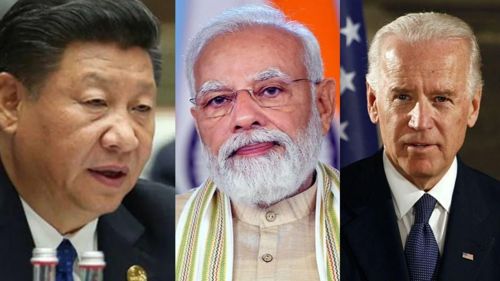Abstract
This paper investigates the dynamic landscape of great power competition in West Asia, with a particular emphasis on the U.S.-China rivalry. By centring on India’s role as a counter-balance to China, the study scrutinises historical ties, the deepening Indo-U.S. partnership, and the evolution of foreign policies. Examining economic, diplomatic, and security dimensions, the research elucidates collaborative endeavours between India and the U.S. to shape West Asia’s geopolitical landscape. The study offers insights into the region’s transformation, underscoring India’s strategic significance in countering China and its broader implications for global stability.
It introduces the central theme of great power competition in West Asia, with a specific focus on the U.S.-China rivalry, highlighting the pivotal role of India in this context. It addresses key challenges within the geopolitical landscape of West Asia, such as the implications of the U.S.-China rivalry and the need for a counter-balance, particularly through India’s strategic involvement, a glimpse into the forthcoming recommendations which include emphasising the imperative need for collaboration between the U.S. and India, especially in security aspects like defence and intelligence sharing. Additionally, it suggests expanding trade and investment ties, with a focus on technology and innovation to address global challenges. It further underscores the importance of responsible governance and international cooperation in addressing shared challenges. Recommendations encompass conflict prevention through diplomacy, economic and financial stability through regulatory frameworks while touching on the significance of people-to-people ties, cultural exchanges, and respecting sovereignty for fostering trust and regional stability which advocates for a comprehensive approach that integrates diplomatic, economic, and security initiatives to promote lasting peace and prosperity in the region.
Introduction
In an era defined by rapidly shifting geopolitical dynamics, the strategic landscape of West Asia has emerged as a focal point of global attention. The region, known for its vast energy resources, intricate web of alliances, and complex historical narratives, has become a crucible of international politics and power struggles. Central to this evolving geopolitical chessboard is the burgeoning rivalry between two of the world’s most influential nations: the United States of America and the People’s Republic of China. As both superpowers seek to expand their influence and secure their interests in West Asia, a new player has increasingly emerged as a pivotal counter-balance i.e. India.
The rise of China as a dominant actor in global affairs, coupled with its growing assertiveness in the Indo-Pacific region, has generated significant concern within the corridors of power in Washington. Simultaneously, India, long seen as a regional powerhouse in South Asia, has expanded its diplomatic and strategic footprint westward. This shift in India’s foreign policy calculus has brought it into the heart of the great power competition between the United States and China, particularly in West Asia.
The geopolitical landscape of West Asia, often referred to as the Middle East, has been marred by complex historical legacies, regional conflicts, and global power struggles for decades. This region, rich in oil and natural gas resources, holds immense significance not only for the nations within it but also for global superpowers vying for influence, stability, and energy security. Against this backdrop, the rise of China as a global power and the United States’ enduring presence in the region have set the stage for a multifaceted great power competition.
Understanding the intricacies of these evolving dynamics in West Asia is essential for comprehending the broader global balance of power. The region’s significance as an energy hub, its role in regional conflicts, and its potential to shape the course of great power rivalries make it a focal point of international attention.
U.S.-China Rivalry in West Asia
The U.S.-China rivalry in West Asia has become a focal point of global geopolitics, driven by a convergence of strategic, economic, and regional factors. West Asia’s pivotal location, vast energy resources, and complex conflicts make it a battleground for influence. China’s Belt and Road Initiative (BRI) has propelled it into a prominent economic role, with investments in infrastructure and energy projects across the region. Meanwhile, the United States, long reliant on West Asian oil, maintains security alliances and military presence to safeguard its interests and maintain influence. This economic and strategic competition is further complicated by differing regional priorities, as countries in West Asia have varying degrees of alignment with the U.S. and China. Iran’s growing ties with China and its adversarial stance toward the U.S., alongside Israel and some Gulf states’ strong U.S. alliances, illustrate the region’s intricate dynamics. The U.S.-China rivalry in West Asia holds implications not only for regional stability but also for the broader global balance of power, making it a critical geopolitical threat in the 21st century.
Click Here To Download The Paper


📌Analysis of Bills and Acts
📌 Summary of Reports from Government Agencies
📌 Analysis of Election Manifestos

